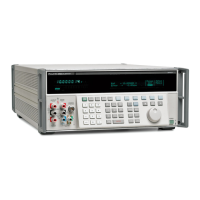5700A/5720A Series II
Operators Manual
5-28
Table 5-2. Commands (continued)
*ESE?
Description Sequential command.
Returns the byte from the Event Status Enable register, described under "Checking the
Calibrator’s Status."
Parameter None
Response (Integer) Decimal equivalent of the register byte.
Example: *ESE?
Returns: "140" if bits 2 (QYE), 3 (DDE), and 7 (PON) are enabled (1) and the rest of the bits
are disabled (0). (See "Checking the Calibrator’s Status" for details.)
*ESR?
Description Sequential command.
Returns the byte from the Event Status Register and clears the register. The ESR is
described under "Checking the Calibrator’s Status."
Parameter None
Response (Integer) Decimal equivalent of the register byte.
Example: *ESR?
Returns: "140" if bits 2 (QYE), 3 (DDE), and 7 (PON) are set (1) and the rest of the bits are
reset (0). (See "Checking the Calibrator’s Status" for details.)
ETIME?
Description Sequential command.
Elapsed time query. The response is the total number of minutes that the power switch has
been on for the life of the instrument. An example of using this command would be detecting
when an interval you set for cleaning the air filter has expired.
Parameter None
Response (Integer) Total number of minutes that the power has been on.
EXPLAIN?
Description Sequential command.
Explains a fault code. This command returns a string that explains the fault code furnished
as the parameter. The fault code (same as the parameter) is originally obtained by sending
the FAULT? query.
Parameter The fault code (an integer).
Response (String) An explanation of the fault code.
Example: EXPLAIN? 725
Returns:
ILLEGAL LIMIT SETTING

